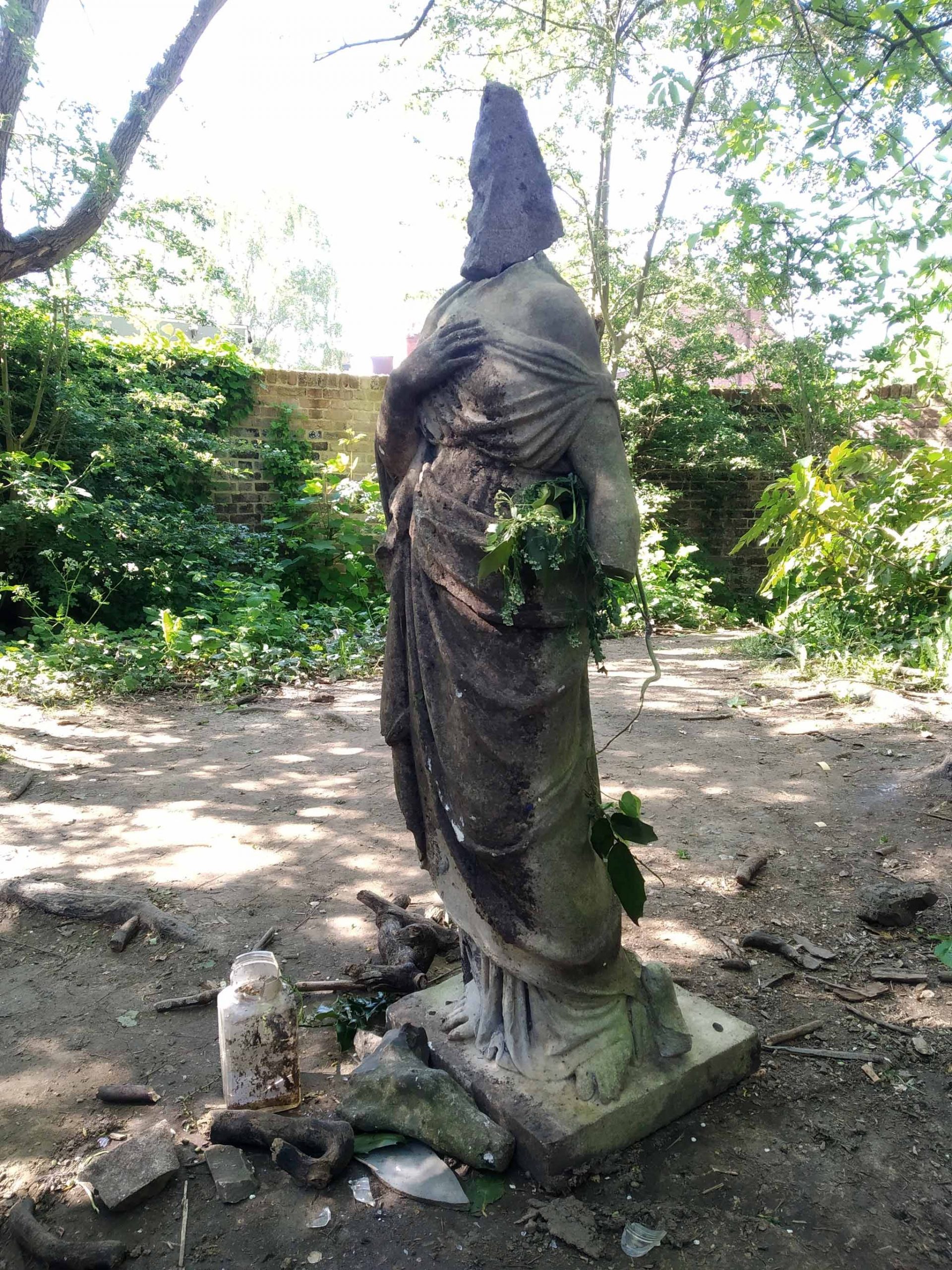Time Stains
Jared Davis thinks through a few dusty and dirty objects
The dust in my room – unsettled from the removal of books, house plants and piles of unfiled bills – catches dryly in my throat, causing a cough and compounding the anxiety of my second day in self-isolation. I’m cleaning because I don’t often get the chance – or rather there’s something I’d prefer to feel productive in doing – but the rupture between two days ago and everything that came before has meant an abundance of spare time along with a desperation to take control of the situation. So I am dusting: the thin grey layer of dead skin cells along the legs of my desk, the more tangible clumps sticking to my rag rug, the northeast corner of my room filled with draping cobwebs that once belonged to a Daddy Longlegs who lived there but who is now likely some of the matter on the aforementioned dusty table legs. Dust is residue, or remains. To be dusty is to be forgotten, unkept, neglected or ignored. But it is also to be old, full of history, stories and secrets.
I’ll never be able to comprehend exactly how much dust is in my bedroom, the dust in its entirety, but I can break down the experience of dust into discrete moments: this clump on the rug I removed, that bit of dust that made me cough or sneeze. It’s quite like how philosopher Timothy Morton describes the experience of climate through raindrops: “you can feel them on your head–but you can’t fully perceive the actual raindrop in itself. You only ever perceive your particular, anthropomorphic translation of raindrops.”1
For Morton, the climate and global warming are what he calls hyperobjects, things at too vast a scale for us to comprehend in human terms, and which challenge what we even think of as ‘things’. The coronavirus pandemic could be another such hyperobject, or so could dust in this instance. Hyperobjects problematise modernity in that where modernity – from the enlightenment to the industrial age onwards – emphasised an ability to rationalise, control and the will of the individual, hyperobjects unravel the sense of human agency this requires.
 Abandoned doll near The Old Church, Stoke Newington by Jared Davis
Abandoned doll near The Old Church, Stoke Newington by Jared Davis
Dusting and cleanliness
It’s probably no coincidence then that I felt compelled to clean when faced with the hyperobject of the coronavirus. Dusting is a common household chore. It’s one you’d assume has been around forever, although domestic tasks as we know them have a very modern history. As recently as the early 20th century the feather duster was a status symbol. But during the post-war period a new cult of cleanliness and the Americanised consumerism around it – detergents, washing machines, Hoovers – gave dusting ubiquity. Cleanliness was a piece with the automobile, household appliances and Modernist architecture in a cosmopolitan mass culture of ‘progress’. A rationalised and universal future: in with the new, the rest is consigned to the dustbin of history.
Academic Kristen Ross has written on this political history of cleanliness. Taking the specific case study of France and its reinvention – as well as its Americanisation – during the post-war Marshall Plan period, cleanliness for Ross fits hand in hand with a desire to be modern. It is a learned, politicised framework, and linked with the gendering of domesticity. Cleanliness and cleaning products were bound with new technologies, commodity fetishism and national identity, further reaffirmed through the propaganda of popular media and advertising. As Ross notes:
The way for these more specialized organs of household technology was paved by the new kinds of attention given to issues of cleanliness and housekeeping in the standard women’s press. The first postwar reissue of Marie Claire in October 1954, for example, declared its intention to “help women feel at ease in the modern age.” That age, it goes on to describe, is “the atomic age but also the age of abundance, of emancipation, of social progress, the age of light, airy houses, of healthy children, of the refrigerator, pasteurized milk, the washing machine, the age of comfort, of quality, and of bargains.”2
Cleanliness is not some universal value; it is tied to cultural conditionings, formed in the modern period that laid foundations for our contemporary present. The social and political turbulence of the 1960s and ’70s famously rocked this false domestic bliss of the Modernist post-war era, leading to an increased culture of expressive individualism. Modernism’s fixation with newness and an international utopian mass culture dissolved into the pluralistic and historically derivative cultural narratives of postmodernism. If this term seemed like a jargonistic buzzword of academia through the 1980s and ’90s, it’s now an inescapable mood for our post-truth present. The past comes back to haunt us like dust resettling on a mantlepiece, while at same time the ideals of modernity seem farcical. In today’s noisy digital mythscape, the dust of past stories constantly muddies debates. Our present moment is dusty.
The politics of cleanliness rear their head today in another way with regard to the virus. Considering cleanliness in relation to hygiene and immunity reveals instances in which the right to life is made political, and not evenly distributed. As writer and queer theorist Paul B. Preciado recently commented:
That wage labor is itself an institution of confinement has never been clearer than now, as we witness “essential” workers as de-munized bodies brutally forced into spaces of lethal risk. The subways of New York are as crowded as ever because the transit authority has severely cut back on the number of trains. The essential workers forced to ride are disproportionately low-income, disproportionately migrants, disproportionately racialized bodies.3
When it comes to immunisation politics, we can see governments neatly use the universalising iconography of cleanliness in a manner that increases control and exacerbates class division, with a sleight of hand like sweeping dust under the rug.
The dust of the past
On February 3, 2020, a few days after the UK split from the European Union, Soho was evacuated following the discovery of an unexploded World War Two bomb beneath Dean Street. It was an ironic intrusion from a past inter-European conflict for the week of Brexit. Wartime is hard to imagine today, with Europe conjoined since the 1970s by the EU, and by the free flows of capitalist realism that became total at the end of the ’80s. The end of history; a never-ending free market.
The Soho café I worked at shut up shop for a day when the bomb was found, as did the surrounding businesses. This seemed at the time an impossible disruption, warhead or no – how can we just close? A month and a half later, we shut our doors indefinitely. We were faced with things familiar to wartime now amidst the pandemic. The same shortages, fear and political rhetoric scampered across the city. Capitalist realism dissolved as markets collapsed. History didn’t seem so finished after all. The bomb sitting for decades underneath Dean Street was excavated, it was a puncture, a small explosion had occurred in the threaded cobwebs of history and the ideologies of everyday life.
A cobweb falls in on itself, turns inside out and around; it is sticky. Once you think it is removed you find remnants of it reappear, stuck to you somewhere else. The cobweb is a useful analogy for this strange sense of time at the moment, with its interlocking and confused fabrics. If the present moment is dusty, it is because our current age is covered in a layer of unsettled dust from past objects and their corresponding stories and timeframes; the meanings ascribed in their appearances. For Morton, “The present does not truly exist”. Rather:
We experience a crisscrossing set of force fields, the aesthetic-causal fields emanated by a host of objects. Anyone familiar with relativity theory will find this idea reasonably intuitive. What is called the present is simply a reification, an arbitrary boundary drawn around things by a particular entity—a state, philosophical view, government, family, electron, black hole.4
A bomb fails to explode on Dean Street. Around 80 years later it is pulled from the mud and rubble beneath the road. It is a loaded marking on the street, telling stories of the governance and conflict which make up the city. These are cultural histories told through aesthetic form, as Morton explains:
The streets beneath the streets, the Roman Wall, the boarded-up houses, the unexploded bombs, are records of everything that happened to London. London’s history is its form. […] The dirt on a building is part of the building’s form, which John Ruskin called the stain of time.5
Where the stories carved in the forms and stains of the city meet the Thames River, the dirt and dust of the past turns into a viscous mud, concealing objects and artifacts then keeping them preserved. Garbage from a heaving city is washed up on the shores of the river. In the opacity of the unclean water one can imagine traces of what would have been a foggier riverbank from the pollution of London’s East End during the industrial age. In this cloudy water are the city’s secrets from that era and earlier. In the mud, stories are concealed and collected until they are unearthed years, even centuries later by mudlarkers.

Fake Medieval medallion by ‘Billy’ and ‘Charley’ depicting a crowned face on one side and a figure in chain mail on the reverse. Image from The Cuming Museum
Dusty and dirty objects
Two such mudlarkers in 19th century London were William Smith and Charles Eaton – ‘Billy’ and ‘Charley’ – who trawled the banks to make a small living off objects that might have been historically loaded. In 1857 Billy and Charley began making crude forgeries of medieval lead medallions and such items. The Billy and Charley forgeries were modern imaginings of what these objects might be. Despite the duo’s limited skills in metalwork and historical inaccuracies including the temporally incorrect use of Arabic numerals, a leap of imagination was enough for an antique dealer named William Edwards to purchase a great deal of them. Billy and Charley claimed the relics had been excavated through works that were being undertaken in the Shadwell Docks. Made from plaster of Paris moulds, Billy and Charley gave their medallions an appearance of age – the ‘stain of time’ – by coating them in river mud.
Having produced up to 10,000 forgeries in their career, Billy and Charley’s handiwork was sold to antique salespeople such as George Eastwood, who in turn would sell them on to buyers including one for the British Museum. When the authenticity of these items was thrown into question by archaeologists, Eastwood would go so far as to sue the journal that published their claims for libel. This in turn drew more perceived legitimacy to the items when the case (which Eastwood lost) did not decisively conclude otherwise. Further narratives were applied to the objects: perhaps they weren’t medieval objects, but rather crude replicas produced in the 16th century. Today, the attention around these Shadwell forgeries and the loaded cultural history they contain have applied a unique value upon them. Now the narrative intrigue of these objects is not in them being authentically medieval, but authentically ‘Billy and Charley’s’. A Shadwell forgery today at auction could be sold for more than an item like those they were attempting to counterfeit. More interestingly, forgeries of these forgeries have been found in circulation. These stained lead medallions embody the muddied narrative life of objects.
Form is loaded with narrative to make up our understanding of the world. Think of magical objects, sigils and sites, whose mystical potential is realised through the cultural ascription of rituals. In the phenomenon of legend tripping – visiting sites of terrible events, hauntings or paranormal activity – the relation between the site and its artifacts, temporalities and ritual is laid bare. Religious studies scholar Michael Kinsella has discussed how legend trippers, in using the latent potential of a site – say an abandoned asylum, some woods where a child went missing, caves with mysterious markings – are able to perform belief. A sound or a shadow can become actualised as a real haunting, a repeat occurrence of past paranormal activities due to the ritualistic performances of a legend trip. As Kinsella notes:
By establishing a ritual or ritual-like play frame in which the supernatural or magic may operate, legend-trippers and magicians reframe their dimensions of experience. Tanya Luhrmann calls this process “interpretive drift” – the tendency for magicians to increasingly interpret events and experiences as magical the more they become involved with practicing magic.6
One of the subjects of Kinsella’s research that is rife with instances of interpretive drift is the phenomenon of Ong’s Hat – an alternative reality game mixing conspiracy theory, hard science and the ritual elements of magical practices. Spreading initially through photocopied pamphlets and early Internet Bulletin Board Systems, the fictitious and collectively written narrative of Ong’s Hat revolves around a secret science experiment in the New Jersey site of its namesake that unlocked secrets of travel to alternate dimensions. This contemporary myth, blending real locations, science, chaos magic and urban legends, transcended a simple binary of fact or fiction, becoming for its participants an analytic and self-reflective unpicking of the very nature of conspiracy, meaning-making and magical practices. The postmodern hive-mind narrative of Ong’s Hat is a distinctly dusty means of reality construction, revolving around loaded sites and objects beyond our comprehension.
Sculpture made from old headstones in Abney Park by Jared Davis
In the dust of this present
“Time is a flurry of spells and counterspells cast by objects themselves,” says Morton.7 This is a fitting illustration of how unfixed our relation with the things around us can feel: we are caught in the middle of this spell casting. I started this text with a recollection of an unsettling time, lived through dust and dusting. Despite the old expression, there can be no “after the dust has settled” in our experience of time. The dust of the past never settles completely, and can just as easily be disturbed and fill the air. The dust of ‘before’ always affects any feeling of ‘afterwards’. Dust can also be a useful analogy for things too large for us to fully grasp, or what Morton calls hyperobjects. Today, staring down the virus, climate change and a capitalist politics that isn’t working for us, we’re enmeshed in hyperobjects that cause grief to our human sense of agency. We might turn to dusting, cleaning, working with smaller objects that we can feel a sense of mastery over. But to really face our dusty present we’d need to work with, rather than against, objects out of our control. We can’t polish clean a time-stained city.
- Morton, Timothy (2013). Hyperobjects: Philosophy and Ecology after the End of the World. Minneapolis, MN: University of Minnesota Press.
- Ross, Kristen (1995). Fast Cars, Clean Bodies: Decolonization and the Reordering of French Culture. Cambridge, MA: The MIT Press.
- Preciado, Paul B. (2020). ‘Learning from the Virus’, Artforum, online at: https://www.artforum.com/print/202005/paul-b-preciado-82823, accessed 14 May, 2020.
- Morton, Timothy (2013). Hyperobjects: Philosophy and Ecology after the End of the World. Minneapolis, MN: University of Minnesota Press.
- Ibid.
- Kinsella, Michael (2011). Legend-Tripping Online: Supernatural Folklore and the Search for Ong’s Hat. Jackson, MS: University Press of Mississippi.
- Morton, Timothy (2013). Hyperobjects: Philosophy and Ecology after the End of the World. Minneapolis, MN: University of Minnesota Press.





